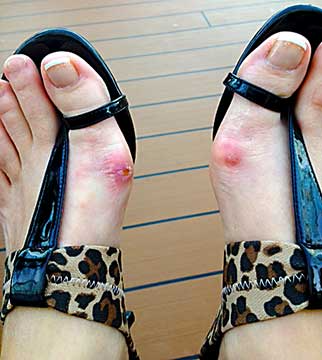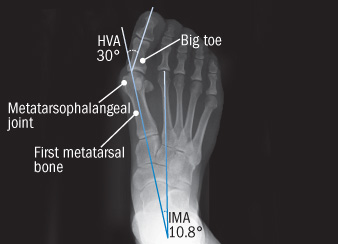Bunions Symptoms and Treatment | Tailors Bunion | Bunion Surgery in Allentown

Learn what causes a bunion, bunion symptoms, and which non-invasive methods Bunion Center of the Lehigh Valley uses to treat them.
A bunion develops when the first metatarsal bone (the metatarsals are the five long bones of the foot) turns outward and the big toe points in toward the other toes, causing the joint to protrude. Most shoes irritate the protrusion and put pressure on the misaligned joint. Eventually, the bursa (a fluid-filled sac that surrounds and cushions the joint) becomes inflamed, and the MTP joint becomes stiff and painful.
Bunions are progressive, which means the longer you wait to treat a bunion, the worse it will become.
Frequently caused by an inherited trait, bunions appear when abnormal mechanics of the foot and ankle cause a structural problem in the foot. Shoes such as high heels can cause the bunion to worsen, but don’t actually cause the bunion.
Symptoms occur most often when wearing shoes that crowd the toes. Long periods standing can aggravate the bunion, causing pain, soreness, inflammation, redness, burning and numbness.
A study involving almost 3,000 women and men ages 56 and older found that women are more likely to develop bunions, and the more severe their bunions are, the lower their quality of life is.
Why your bunion needs treatment?

The MTP joint, where your big toe meets the first metatarsal bone, bears and distributes your body weight. When a bunion forms, the misaligntment of the bones, tendons, and ligaments can significantly affect the way your foot functions. A bunion may damage the other toes, causing them to develop corns, calluses, or become bent, forming hammertoes or crossover toes. Ingrown toenails and discomfort in the ball of your foot may also develop, as you shift your weight off of the painful area. As the bunion becomes more uncomfortable, you may have to curtail exercise and other activities.
What Is a Tailor’s Bunion?
Tailor’s bunion, also called a bunionette, is a prominence of the fifth metatarsal bone at the base of the little toe. This prominence occurs at the metatarsal head, where it meets the toe. Tailor’s bunions are not as common as bunions, which occur on the inside of the foot, but they are similar in symptoms and causes.
The deformity received its name centuries ago, when tailors sat cross-legged all day with the outside edge of their feet rubbing on the ground. This constant rubbing was believed to lead to a painful bump at the base of the little toe. See more bunion surgery videos in our video library.
Bunion Symptoms
The symptoms of a bunion include redness, swelling, and pain at the site of the enlargement. These symptoms are caused by shoes that rub against the enlargement, irritating the soft tissue underneath the skin and the bursa around the joint, producing inflammation.
Bunion Treatment
Your podiatrist at PA Foot and Ankle Associates may recommend one or a number of these treatments:
- Shoe modifications: Choose shoes that have a wide toe box and avoid those with pointed toes or high heels
- Padding placed over the bunion to reduce pain
- Oral pain medications: Nonsteroidal anti-inflammatory drugs (NSAIDs), such as ibuprofen may help relieve the pain and inflammation
- Icing to reduce pain and inflammation
- Injection therapy of corticosteroid to treat the inflamed tissue around the joint
- Orthotic devices worn inside shoes to shift body weight off of painful areas
When Is Bunion Surgery Needed?

Bunion surgery is often recommended when non-invasive methods fail to reduce pain. In selecting the procedure or combination of procedures for your case, the podiatric surgeon will take into consideration the extent of your deformity, your age, your activity level, and other factors. The length of the recovery period will vary, depending on the bunion procedure performed.
We offer a variety of different procedures to correct any bunion deformity; including revisional surgery to correct previous failed procedures.
Watch a video bunionectomy using SonicPin. This unique procedure uses a heat activated polymer, instead of screws, to fixate the bones.
Learn about a revolutionary new bunion surgery which leaves virtually no scar and causes minimal to no pain.

